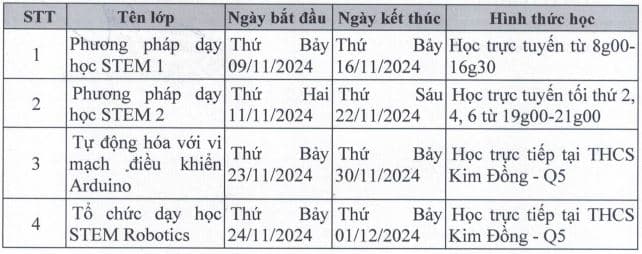STEM training schedule for November 2024 in Ho Chi Minh City
STEM training schedule for November 2024 in Ho Chi Minh City
On October 18, 2024, the Information and Education Program Center under the Department of Education of Ho Chi Minh City issued Notification 42/TTTT-CTGD in 2024 regarding the STEM training schedule for November 2024 (download).
The Information and Education Program Center under the Department of Education of Ho Chi Minh City announces the STEM training schedule for November as follows:

More details: Notification 42/TTTT-CTGD in 2024 regarding the STEM training schedule for November 2024 (download)

STEM training schedule for November 2024 in Ho Chi Minh City (Image from the Internet)
What are steps for developing a STEM lesson in Vietnam?
Based on subsection 1 Section 4 Official Dispatch 3089/BGDĐT-GDTrH in 2020, the steps to develop a STEM lesson are as follows:
Step 1: Select the teaching content
Based on the knowledge content in the subject program and the phenomena, processes associated with that knowledge in nature, society; procedures or technological devices applying that knowledge in practice to select the content of the lesson.
Step 2: Identify the problem to be solved
Identify the problem to be solved for the students to carry out so that when solving that problem, students must learn the necessary knowledge and skills to be taught in the chosen subject program or apply known knowledge and skills to construct the lesson.
Step 3: Develop criteria for the product/solution to solve the problem
Clearly define the criteria of the solution/product as the important basis for proposing a scientific hypothesis/solution to the problem/design of the product sample.
Step 4: Design the organizational process of teaching activities.
- The organizational process of teaching activities is designed according to active teaching methods and techniques with learning activities encompassing the steps of the technical process.
- Each learning activity is clearly designed regarding its purpose, content, expected learning products that students must complete, and the organization of learning activities. These learning activities can be organized both inside and outside the classroom (at school, at home, and in the community).
- It is necessary to design an electronic lesson on the network to guide and support students’ learning activities outside the classroom.
What are the contents for designing of a STEM lesson process in Vietnam?
According to subsection 1 Section 4 Official Dispatch 3089/BGDĐT-GDTrH in 2020, the activity content can be compiled into sections containing information such as materials, accompanied by commands or activity requirements for students to explore, intellectually process to solve the problem presented in the activity.
The organizational method of activities shows the teaching method, describing how to organize each section of the activity content for students to achieve the corresponding purpose.
- Activity 1: Identify the problem
Teachers assign learning tasks to students containing problems. In doing so, students must complete a learning product or solve a specific problem with criteria that require students to use new knowledge in the lesson to propose, construct solutions. The criteria of the product are extremely important, requiring students to thoroughly understand new knowledge to design and explain the design for the required product.
- Activity 2: Explore the foundational knowledge and propose solutions
Organize to allow students to engage in active learning activities, increasing the level of self-reliance depending on each student under the flexible guidance of the teacher. Encourage students to actively seek, acquire knowledge to use in proposing, designing products.
- Activity 3: Select the solution
Organize for students to present, explain, and defend the design with explanations (using newly learned and prior knowledge); teachers organize feedback, focus on editing, and validate students’ explanations for them to master new knowledge and continue to refine the design before proceeding with creation, testing.
- Activity 4: Create prototypes, test, and evaluate
Organize for students to manufacture prototypes according to the design, combining testing during the manufacturing process. Guide students to evaluate the prototype and adjust the initial design to ensure feasibility.
- Activity 5: Share, discuss, adjust
Organize for students to present completed learning products; exchange, discuss, evaluate to continue adjusting, improving.

